Слайд 2

This course aims to provide students with the theoretical and practical
aspects of Teaching English to Young Learners (TEYL).
Слайд 3

More specifically, the course addresses issues related to:
- theories of learning,
- the learning strategies of young children, - teaching-learning activities,
- the classroom methods and techniques to be used when teaching English to young learners;
- the development of games, songs and visual materials and their use in teaching and assessment of young English learners.
Слайд 4

Why is it important to know how to teach English to
Young Learners?
Слайд 5
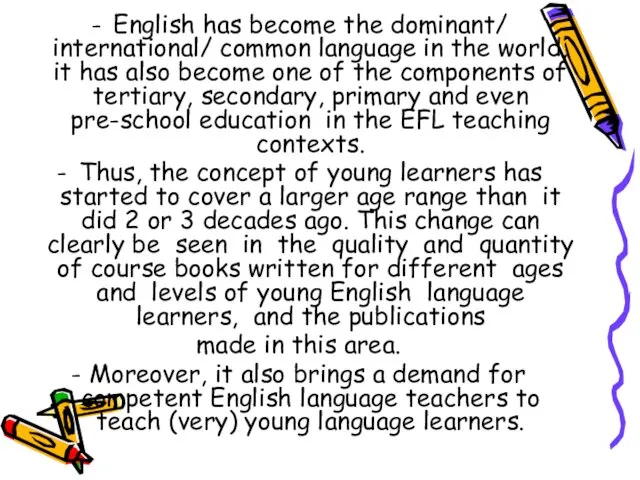
English has become the dominant/ international/ common language in the world,
it has also become one of the components of tertiary, secondary, primary and even pre-school education in the EFL teaching contexts.
Thus, the concept of young learners has started to cover a larger age range than it did 2 or 3 decades ago. This change can clearly be seen in the quality and quantity of course books written for different ages and levels of young English language learners, and the publications
made in this area.
- Moreover, it also brings a demand for competent English language teachers to teach (very) young language learners.
Слайд 6
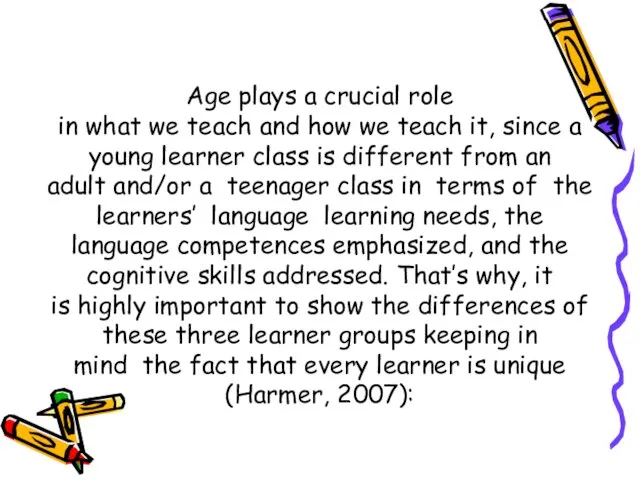
Age plays a crucial role
in what we teach and how
we teach it, since a young learner class is different from an
adult and/or a teenager class in terms of the learners’ language learning needs, the
language competences emphasized, and the cognitive skills addressed. That’s why, it
is highly important to show the differences of these three learner groups keeping in
mind the fact that every learner is unique (Harmer, 2007):
Слайд 7

Слайд 8
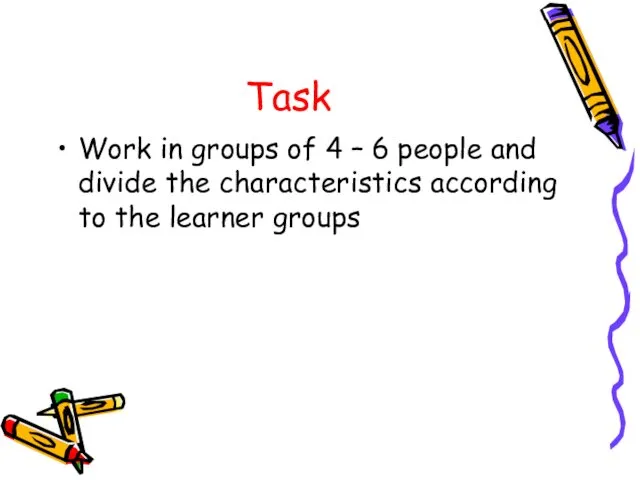
Task
Work in groups of 4 – 6 people and divide
the characteristics according to the learner groups
Слайд 9
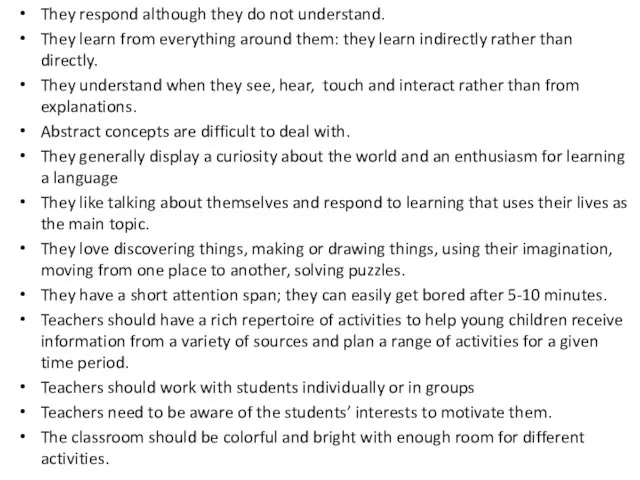
They respond although they do not understand.
They learn from everything
around them: they learn indirectly rather than directly.
They understand when they see, hear, touch and interact rather than from explanations.
Abstract concepts are difficult to deal with.
They generally display a curiosity about the world and an enthusiasm for learning a language
They like talking about themselves and respond to learning that uses their lives as the main topic.
They love discovering things, making or drawing things, using their imagination, moving from one place to another, solving puzzles.
They have a short attention span; they can easily get bored after 5-10 minutes.
Teachers should have a rich repertoire of activities to help young children receive information from a variety of sources and plan a range of activities for a given time period.
Teachers should work with students individually or in groups
Teachers need to be aware of the students’ interests to motivate them.
The classroom should be colorful and bright with enough room for different activities.
Слайд 10
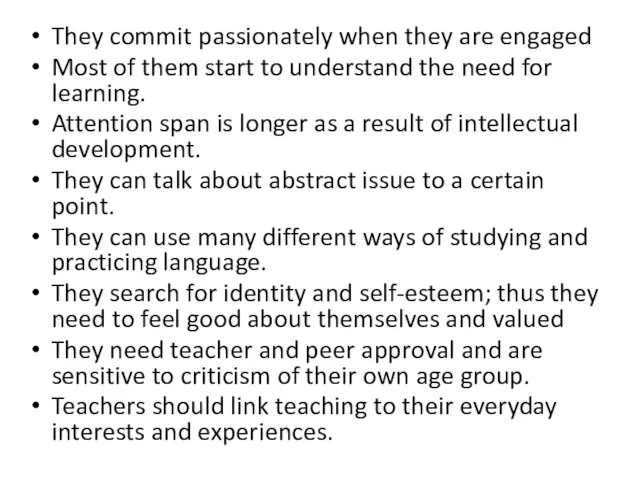
They commit passionately when they are engaged
Most of them start
to understand the need for learning.
Attention span is longer as a result of intellectual development.
They can talk about abstract issue to a certain point.
They can use many different ways of studying and practicing language.
They search for identity and self-esteem; thus they need to feel good about themselves and valued
They need teacher and peer approval and are sensitive to criticism of their own age group.
Teachers should link teaching to their everyday interests and experiences.
Слайд 11
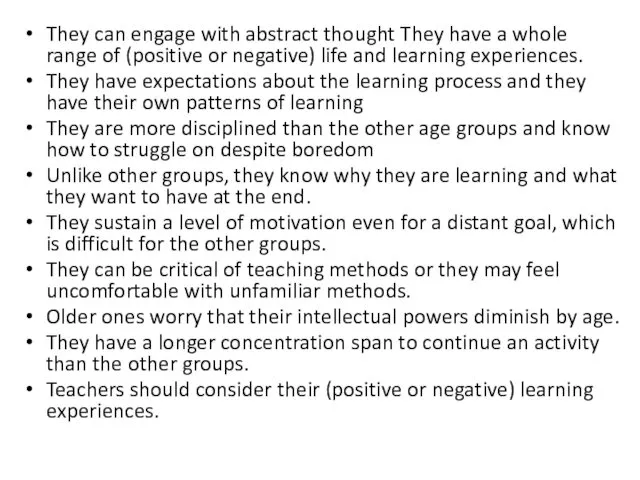
They can engage with abstract thought They have a whole range
of (positive or negative) life and learning experiences.
They have expectations about the learning process and they have their own patterns of learning
They are more disciplined than the other age groups and know how to struggle on despite boredom
Unlike other groups, they know why they are learning and what they want to have at the end.
They sustain a level of motivation even for a distant goal, which is difficult for the other groups.
They can be critical of teaching methods or they may feel uncomfortable with unfamiliar methods.
Older ones worry that their intellectual powers diminish by age.
They have a longer concentration span to continue an activity than the other groups.
Teachers should consider their (positive or negative) learning experiences.
Слайд 12
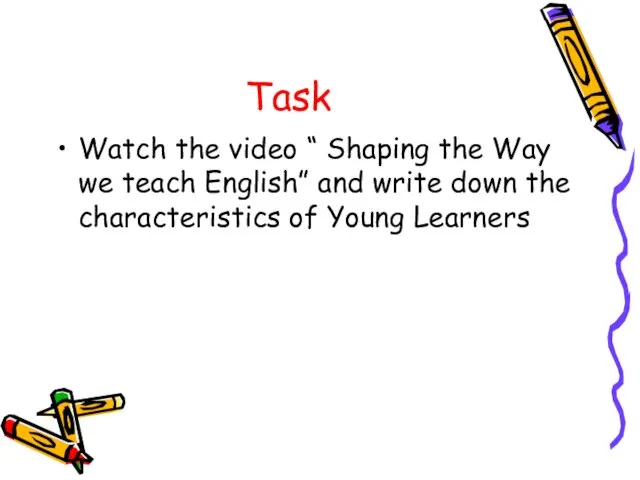
Task
Watch the video “ Shaping the Way we teach English”
and write down the characteristics of Young Learners
Слайд 13

Слайд 14
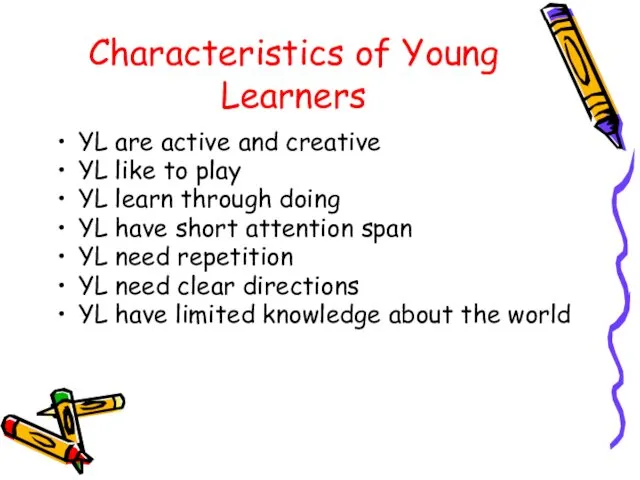
Characteristics of Young Learners
YL are active and creative
YL like to play
YL
learn through doing
YL have short attention span
YL need repetition
YL need clear directions
YL have limited knowledge about the world
Слайд 15
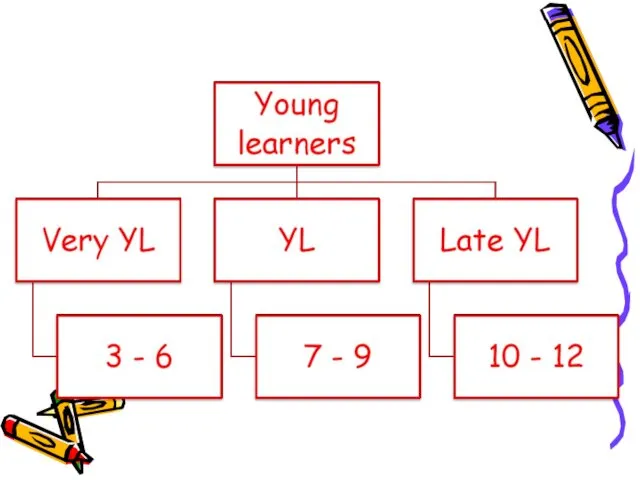
Слайд 16
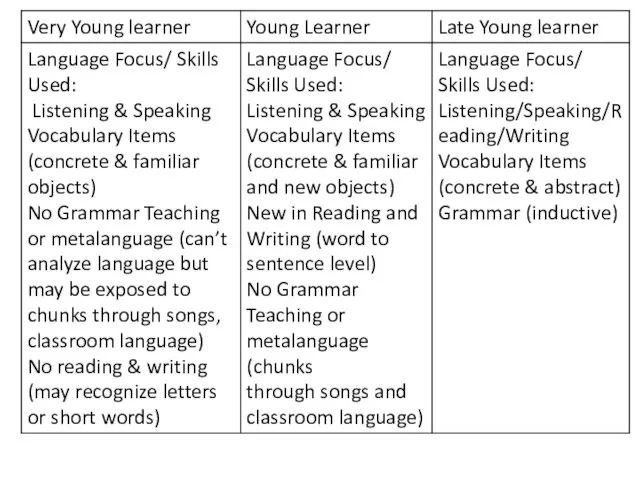
Слайд 17
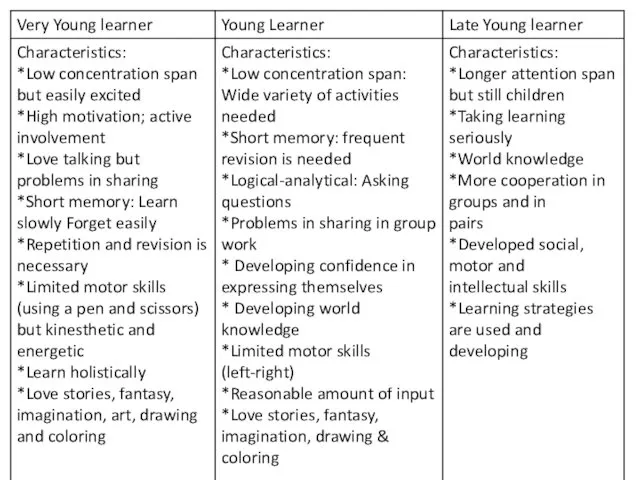
Слайд 18
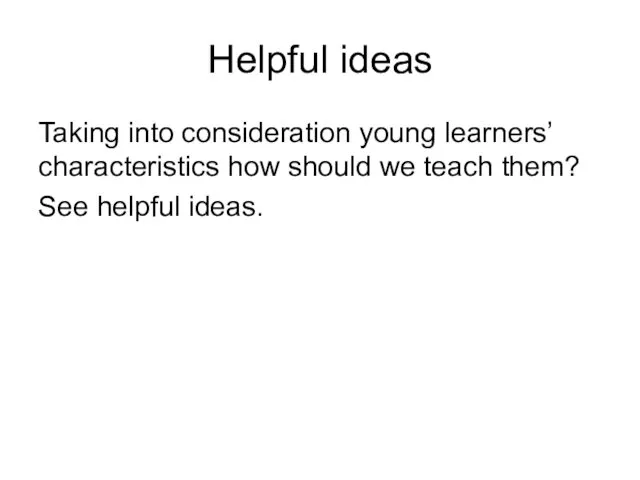
Helpful ideas
Taking into consideration young learners’ characteristics how should we
teach them?
See helpful ideas.
Слайд 19
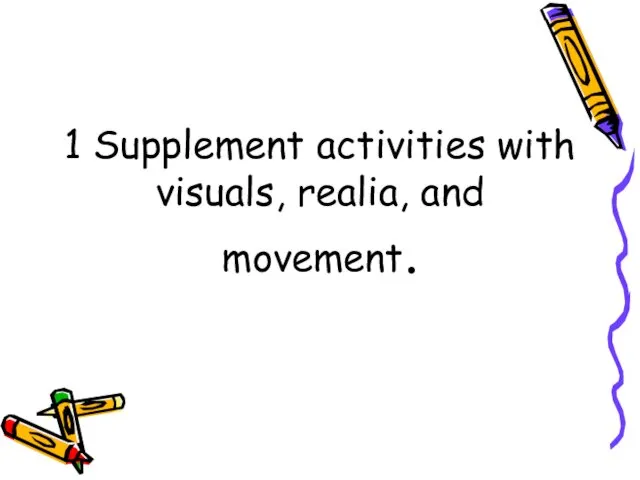
1 Supplement activities with visuals, realia, and movement.
Слайд 20
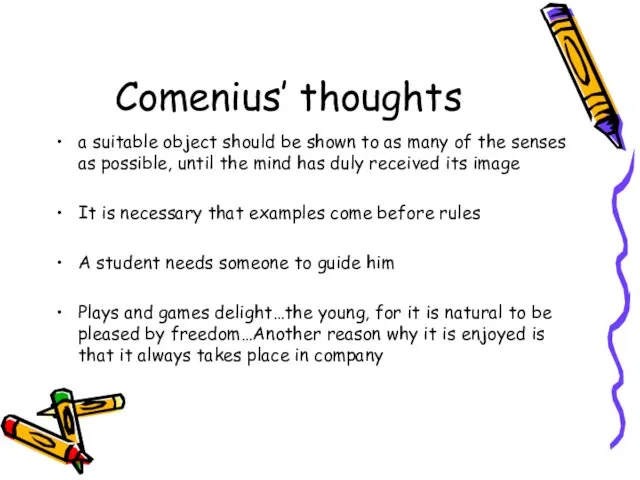
Comenius’ thoughts
a suitable object should be shown to as many of
the senses as possible, until the mind has duly received its image
It is necessary that examples come before rules
A student needs someone to guide him
Plays and games delight…the young, for it is natural to be pleased by freedom…Another reason why it is enjoyed is that it always takes place in company
Слайд 21
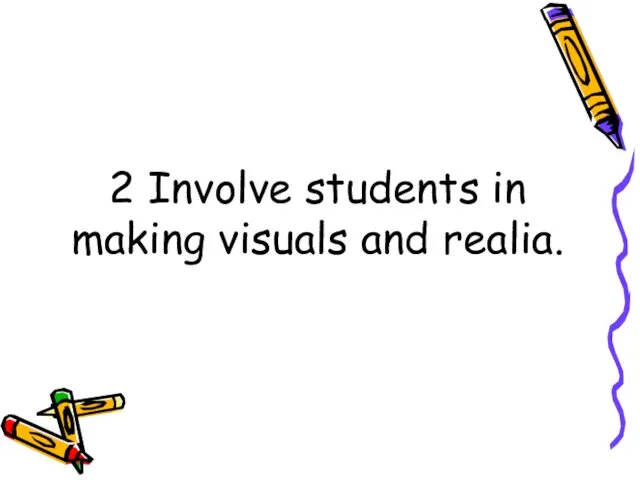
2 Involve students in making visuals and realia.
Слайд 22
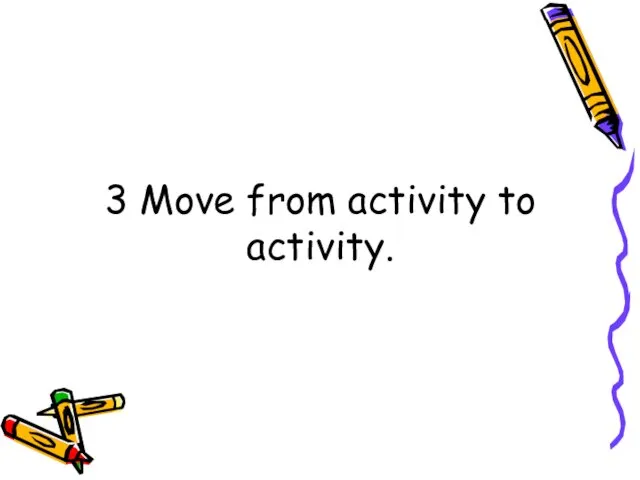
3 Move from activity to activity.
Слайд 23
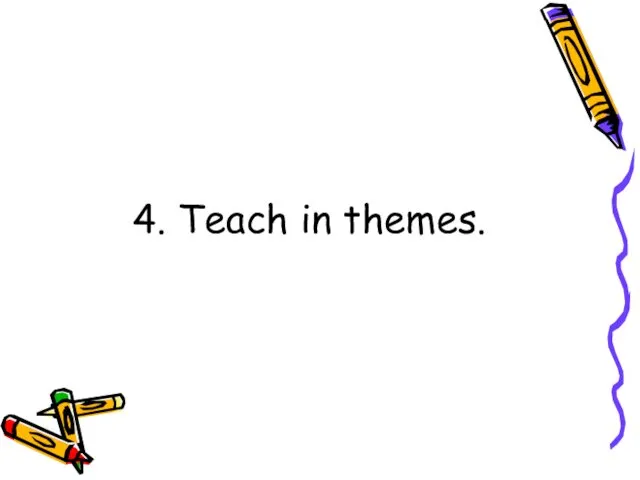
Слайд 24
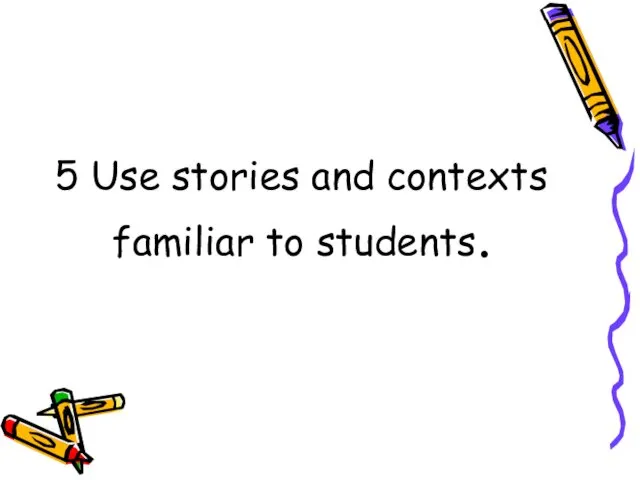
5 Use stories and contexts familiar to students.
Слайд 25
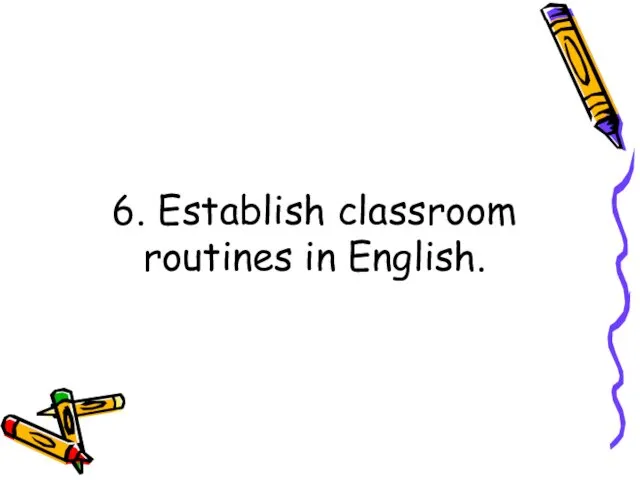
6. Establish classroom routines in English.
Слайд 26
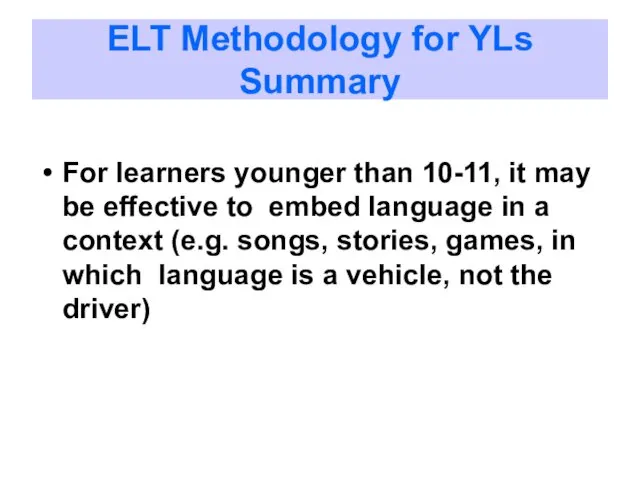
ELT Methodology for YLs Summary
For learners younger than 10-11, it may
be effective to embed language in a context (e.g. songs, stories, games, in which language is a vehicle, not the driver)
Слайд 27
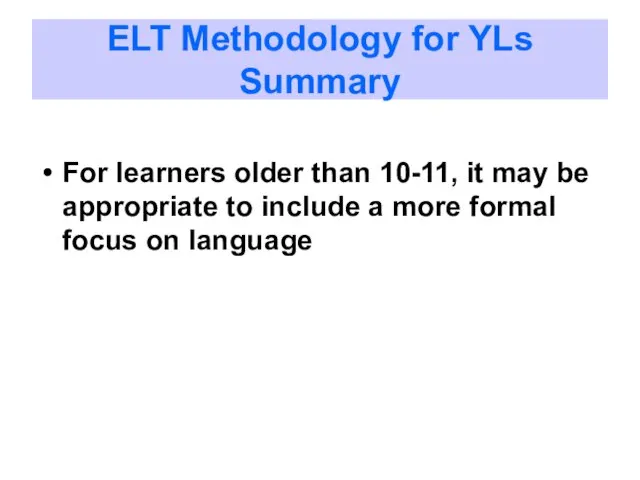
ELT Methodology for YLs Summary
For learners older than 10-11, it may
be appropriate to include a more formal focus on language
Слайд 28
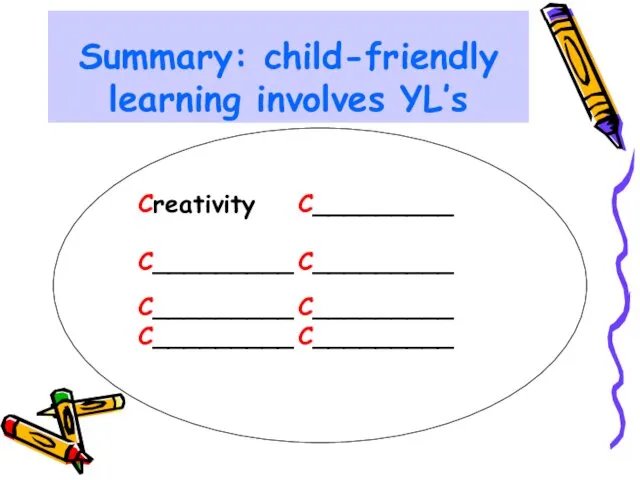
Summary: child-friendly learning involves YL’s
Creativity C_________
C_________ C_________
C_________ C_________
C_________ C_________
Слайд 29

Creativity Context
Community Connections
Care Coherence
Curiosity Challenge
Summary: child-friendly learning involves YL’s
Слайд 30

Is Younger better?
Task: With your partner write down all advantages and
disadvantages of learning English at a young age.
Слайд 31
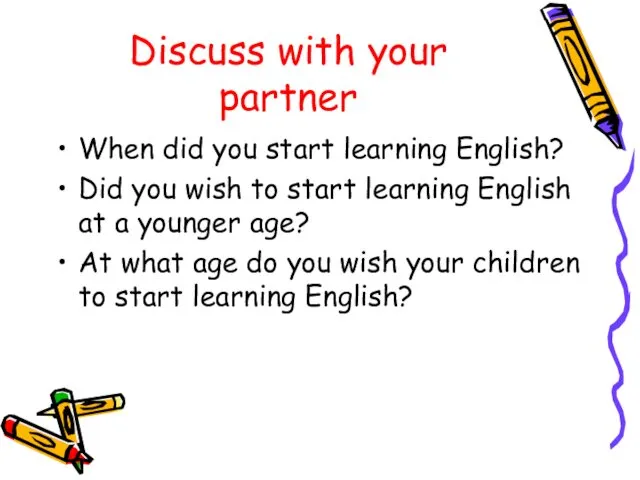
Discuss with your partner
When did you start learning English?
Did you wish
to start learning English at a younger age?
At what age do you wish your children to start learning English?
Слайд 32
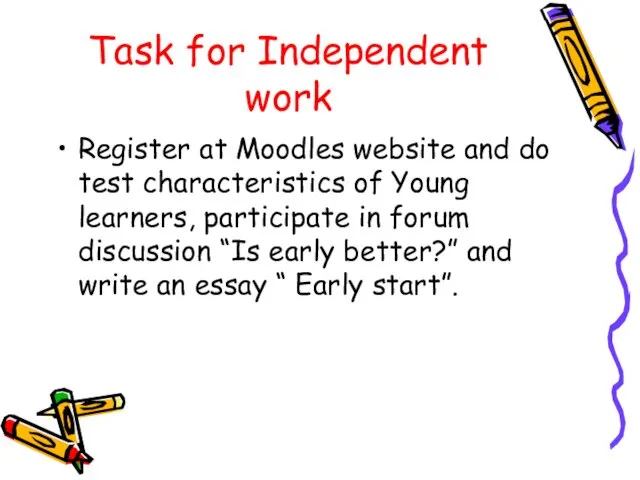
Task for Independent work
Register at Moodles website and do test
characteristics of Young learners, participate in forum discussion “Is early better?” and write an essay “ Early start”.































 Education system
Education system Kadnikov is the town on the hill
Kadnikov is the town on the hill How my profession can change the world. Design
How my profession can change the world. Design Spotlight 7. Module 3. Profiles
Spotlight 7. Module 3. Profiles Enjoy your Meal
Enjoy your Meal Numbers
Numbers St Patrick’s Day
St Patrick’s Day Формирование коммуникативных и познавательных УУД у учащихся через организацию работы с текстом на уроках английского языка
Формирование коммуникативных и познавательных УУД у учащихся через организацию работы с текстом на уроках английского языка Предлоги для обозначения конкретного момента во времени
Предлоги для обозначения конкретного момента во времени Describing people
Describing people The Dutch higher education system
The Dutch higher education system Articles
Articles Communicative Language Teaching Plan
Communicative Language Teaching Plan Why i love me school
Why i love me school Islam
Islam My family
My family Leonardo di ser Piero da Vinci. meaning Leonardo, son of (Mes)ser Piero from Vinci.
Leonardo di ser Piero da Vinci. meaning Leonardo, son of (Mes)ser Piero from Vinci. Job interview
Job interview The family - present progressive
The family - present progressive Country I want to visit is France
Country I want to visit is France English in Use
English in Use My future job. Biomedical engineer specialist
My future job. Biomedical engineer specialist Learning to write letters
Learning to write letters Present Perfect Tense
Present Perfect Tense Angel falls
Angel falls Define the time of the action
Define the time of the action Rheumatic Endocarditis
Rheumatic Endocarditis Past Simple/Past Indefinite (прошедшее простое время)
Past Simple/Past Indefinite (прошедшее простое время)